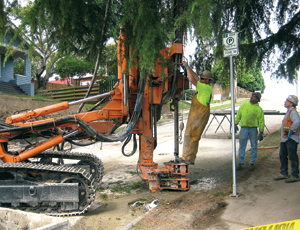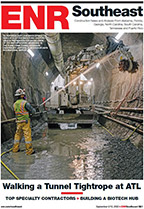Crews have filled in about 80% of nine voids leftover from a 2-mile tunneling job through Seattle’s Beacon Hill. Japan’s Obayashi Corp. did not discover the voids while boring the parallel, 1-mile tunnels as part of its $280-million contract, which has since increased to $312 million. Owner Sound Transit contends the contractor is at fault.

The new, $2.6-billion, 16-mile Link Light Rail from downtown Seattle south to Seattle-Tacoma International Airport required tunnels and a station 180 ft deep beneath Beacon Hill. Obayashi in 2004 won the contract to bore the 21-ft-dia tunnels. During tunneling from 2006 to 2008, the tunnel-boring machine hit pockets of flowing, “cohesionless” sand, causing Obayashi to excavate more material in some areas than needed, says Bruce Gray, Sound Transit spokesman.
While the amounts of excavated earth were noted during tunneling, Obayashi attributed it to conveyor-belt issues, Gray says. “It ended up leaving us with these underground voids,” he says. The voids are within 300 ft of the station.
“We put Obayashi on notice that we think this is an avoidable situation, and the cost is going to be withheld from its final payment,” Gray says. Sound Transit has spent $1.6 million filling the voids.
“The adequacy of the geotechnical data supplied by Sound Transit and the actual behavior of the ground during construction are under discussion with Sound Transit,” says Obayashi spokeswoman Carmen Stone.
A Seattle homeowner found a large hole while gardening in March 2009. Geotechnical teams started investigating. “We went back and looked at scale weight to pinpoint where larger amounts were being hauled out than what was normal for [that] section,” Gray says.
Seattle�s Shannon & Wilson Inc. used focused drilling to find the nine voids and fill them with 2,250 cu yd of pumped-in low-strength concrete. �We drilled from the top until we hit a point of [little to no] resistance,� Gray says. �You pull the drill out and drop a camera in there to get an idea of what you are dealing with. Then you come back and literally drop a hose down and fill it up.�
Sound Transit estimates there is still about 430 cu yd left to identify and fill. There were five voids in the northern section and four in the southern portion. Trains started operating under Beacon Hill in July 2009.




Post a comment to this article
Report Abusive Comment